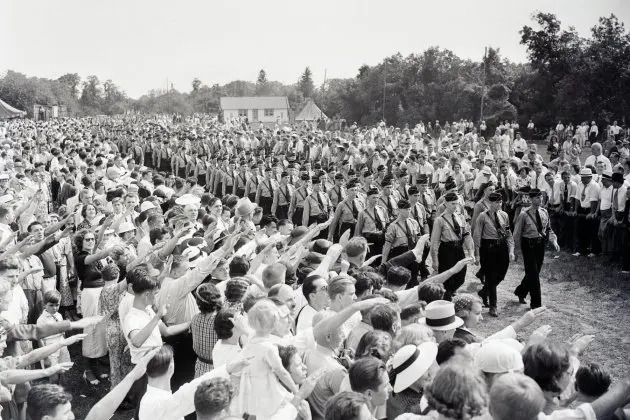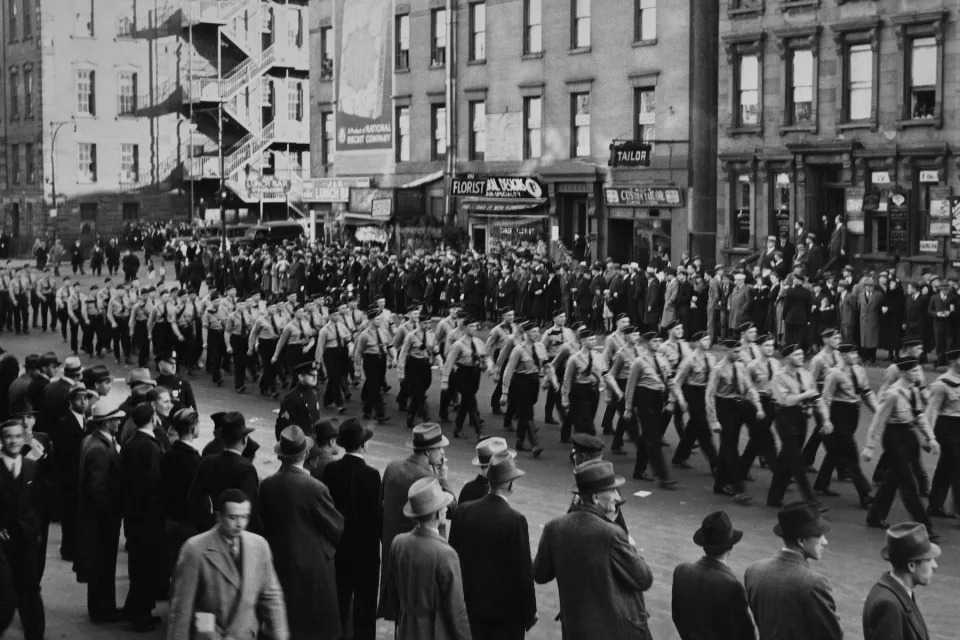The New York Nazis Who Loved Hitler,
Hated Jews, and Packed MSG
Chris Vognar
Tue, January 23, 2024

Hundreds of German Americans give the Nazi salute to young men marching in Nazi uniforms at Camp Sigfried on Long Island, NY. - Credit: Getty
On Feb. 20, 1939, more than 20,000 yelling, cheering people packed New York City’s Madison Square Garden. They weren’t there for a basketball game or a concert. They were supporters of the German American Bund, a pro-Nazi organization that was ready for an alternative to democracy. They waved Swastika flags and raised quite a ruckus. And they were hardly alone in their mission, as the new PBS American Experience documentary Nazi Town, USA makes abundantly clear.
While most Americans identified fascism and the Third Reich as existential threats to civilization, many saw an opportunity to ride the hate toward their vision of a purified white Christian country, free of all those Blacks and Jews and foreign languages (except German, of course). Remember, this was a country that had millions of Ku Klux Klan members in the Twenties, and which considered raging antisemites Henry Ford and Charles Lindbergh national heroes. Father Charles Coughlin regularly thundered against Jewishness on his popular radio broadcast. Into this milieu stormed a German immigrant named Fritz Julius Kuhn, who saw the U.S. as an ideal place to plant the Nazi flag. The Bund, based in the Upper East Side neighborhood of Yorkville, started summer camps for their aspiring Aryan offspring, including Camp Siegfried, on Long Island, where little towheaded kids frolicked and learned the ways of the so-called “master race,” and where visitors could march down Adolf Hitler Street. It can’t happen here, you say? In a sense, it already did.
American Experience puts a stable of eminent historians on the case, as it is wont to do, including Beverly Gage, William Hitchcock and Sarah Churchwell, who lay out cold, hard, and hard-to-believe facts that, upon reflection, are actually all-too-believable. Is it really that big a jump from embracing eugenics, as too much of the American scientific community did, to throwing up a Nazi salute? Nazi Town, USA argues that the U.S. was fertile ground for such social experiments, and, if you read between the lines, suggests it could be again. As Churchwell puts it, “Fascism is always homegrown.” In other words, even if Kuhn and his cohorts used Nazi ideology and symbolism to further the cause, many natives were already primed to sign up.
The black-and-white footage can be both terrifying and hilarious. You have American Nazis marching through American streets, and American flags proudly displayed alongside Swastikas (the Bund loved to wrap itself in patriotism). You also have pathetic little men in their paintbrush mustaches trying to emulate their ideological daddy, the Fuhrer. Fiction has tackled such circumstances in the past, including The Plot Against America, Philip Roth’s novel that imagines a Lindbergh presidency, and The Man in the High Castle, the Philip K. Dick novel (which became a TV series) about what happened when the Axis powers won World War II and ruled over a partitioned America. But in many ways the truth is more jarring, largely because it’s more mundane. FBI head J. Edgar Hoover, for instance, was no fan of the Bund and its ilk. But he was in no hurry to crush them; he found their staunch anti-communist crusade rather useful. Strategery! (Gage, it should be noted, is the author of a superb Hoover biography, G-Man, published in 2022).

The German American Bund march in New York City on February 20, 1939.
Of course not everyone rolled over for the American Nazis. Dorothy Thompson, the first American journalist to be expelled from Nazi Germany in 1934, sounded the alarm early, and was on hand at Madison Square Garden as a heckler, as thousands more protested outside. New York City mayor Fiorello La Guardia worked up an investigation of the Bund’s finances, District Attorney Thomas Dewey got an indictment, and Kuhn was convicted of forgery and larceny, which landed him in Sing Sing. He was eventually deported. World War II over, the head of the snake exiled, the snake itself withered.
But it never really dies. Aside from capturing an overlooked chapter of 20th century American history, Nazi Town, USA is a bracing reminder to never take democracy for granted. There will always be those who see it as a threat and stand ready to uproot it, preferring the bullying rhetoric of strongman leaders. Hopefully they will never again sully the Garden.
No comments:
Post a Comment